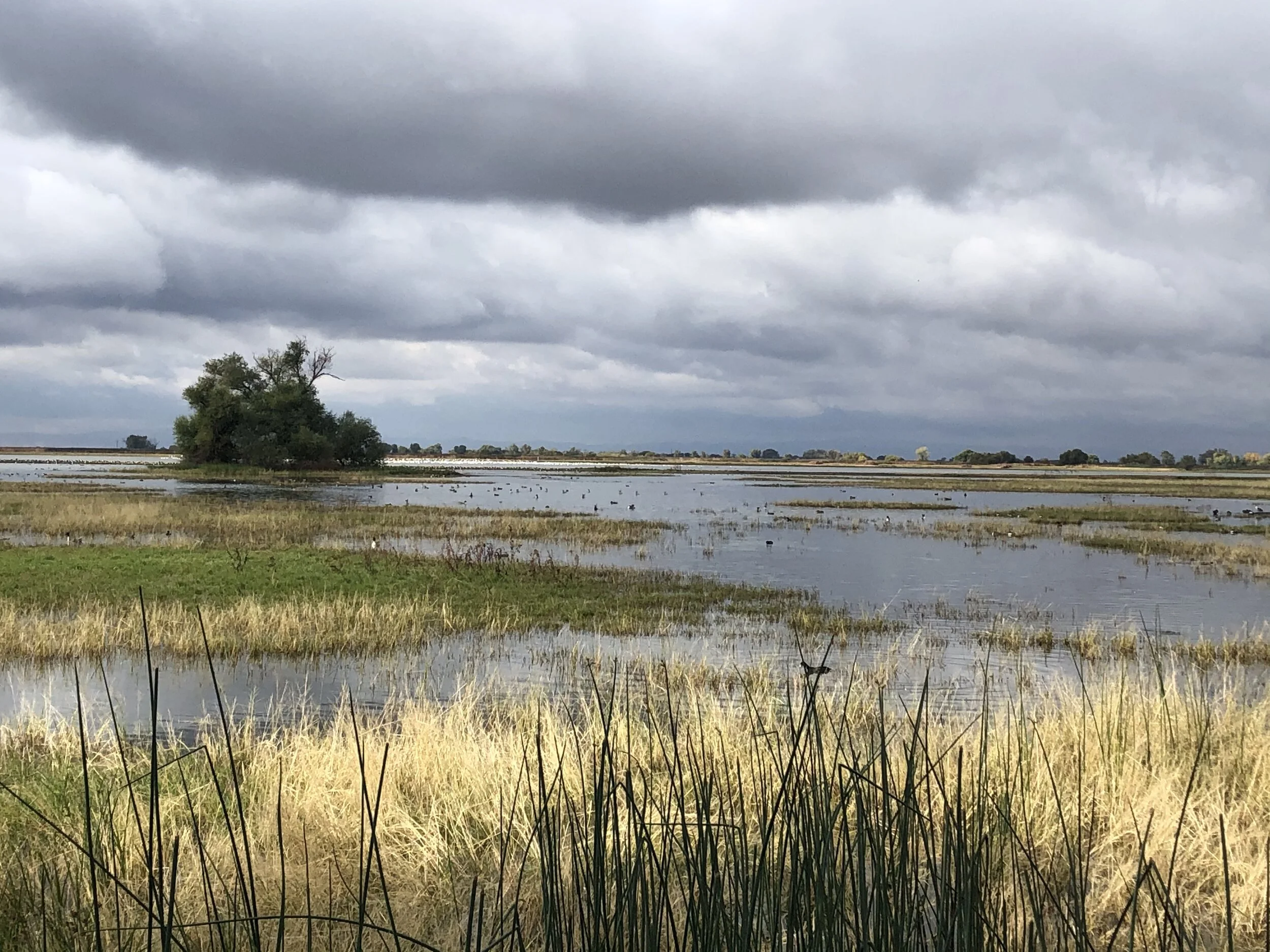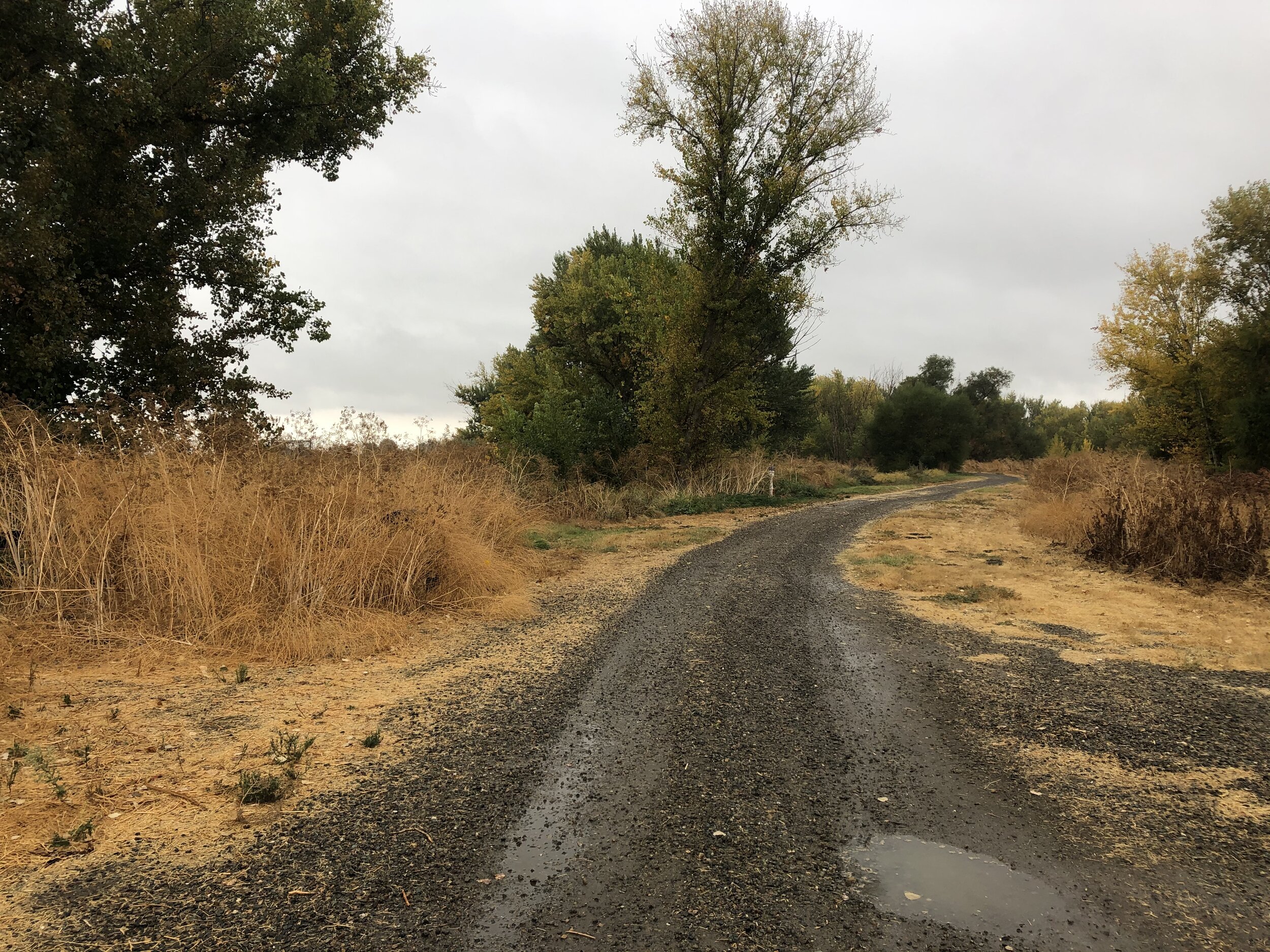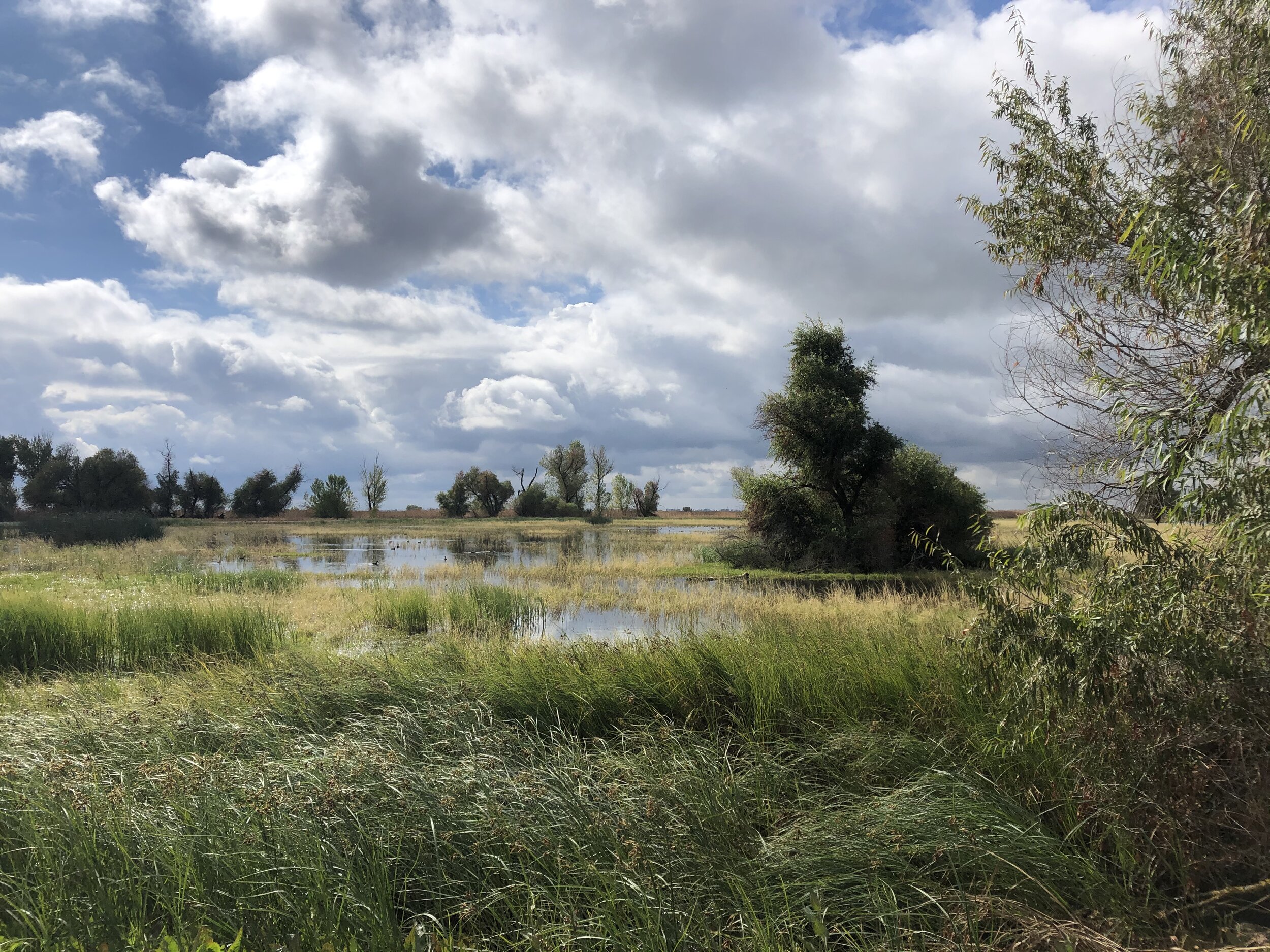Merced NWR (Winter):
A Crane and Waterfowl Wonderland!
by Matthew Dodder
For more than 20 years I have brought my adult school class to this Central Valley refuge—usually just before Thanksgiving. Often, Cricket and I will return in January when the complement of birds is slightly different and Waterfowl numbers peak. But whether you want to see and hear Sandhill Cranes rattling loudly and dancing together, or enormous swirling clouds of Snow and Ross’s Geese by the thousands, this destination is one of visual and aural extremes. There are decidedly few experiences more life-affirming than a winter trip to Merced NWR!
Key Birds: Snow Goose, Ross’s Goose, Greater White-fronted Goose, Cackling Goose, Sandhill Crane, American Cattle-Egret, White-faced Ibis, Bald Eagle, Ferruginous Hawk, Great Horned Owl, Prairie Falcon, Loggerhead Shrike, Horned Lark
Trip Covers: November - January
How to Bird
The refuge is dominated by a 5-mile counterclockwise auto tour on a gravel road, two strategically placed observation platforms, and two birding trails where you can get out and walk. Arrive as early in the day as you can manage, and allow about 4 hours to explore the refuge. If you leave the refuge after lunch, you will likely beat the worst afternoon traffic and be home before dark.
Sandhill Crane and White-faced Ibis Flock by Chuq Von Rospach
A Note about Weather:
The central valley can be very cold in winter, and thick Tule fog can make observation difficult. These conditions can make for it very exciting for photographers who enjoy slate-gray skies, frost-covered fields and small frozen puddles encrusted with autumn leaves. But weather and change go hand-in-hand; be prepared for bitter cold mornings which occasionally become pleasant sunny afternoons…
First Platform:
Let’s start with the first platform and the nearby birding trails. As soon as you enter the refuge you pass through a double row of cottonwood trees leading to the large main lot. Pit toilet restrooms are on your right and a wheelchair accessible platform on your left.
View from first platform. Photo by Matthew Dodder
I recommend beginning by surveying the area from the elevated platform (wheelchair accessible). Instructive signage will orient you on the water management of the property, and the birds that frequent it during the year. Without too much work, you should be able to view several of the target species including Sandhill Cranes in the fields close to the road, and various Geese in the ponds to your to your right. Wilson’s Snipe may be seen hiding on the muddy edges of the reeds, and both Virginia Rail and Sora can be found directly below the platform if sufficient water is present. White-faced Ibis may occasionally be seen close to the platform, but are often seen flying overhead in large groups.
What should be noticeable immediately upon getting out of your car is the sound of this remarkable area—Geese, Ducks, Cranes, Killdeer, White-crowned and Golden-crowned Sparrows, Common Yellowthroat, etc. It is overwhelming in fact. But don’t despair at your inability to separate them all—these sounds will be with you throughout your visit, and quickly you might even be able to identify different species of Geese by their various calls! Watch particularly for “lift-offs”—spectacular clouds of noisy Geese and Ducks in panicked escape-mode, often driven from the ponds by a predator such as a Bald Eagle!
Hundreds of Geese by Chuq Von Rospach
Deadman’s Creek: Meadowlark Trail and Kestrel Trail (2 miles total)
After getting a sense of the birds on the water and in the open fields, walk back toward the entrance road and take a left along the creek. The riparian habitat features many cottonwoods, willows, dense understory and adjacent grassland. Unfortunately, this portion of the refuge is not suited for wheelchairs.
Deadman’s Creek. Photo by Matthew Dodder
The grove often contains Red-shouldered Hawk, Great Horned or American Barn Owls, as well as Downy Woodpecker, Northern Flicker, and other woodland species. The muddy banks of the creek are good for Fox Sparrow and Lincoln’s Sparrows. It’s best to walk slowly and quietly in this area as Wilson’s Snipe or other Shorebirds may be present and tend to flush quickly. There are a couple of routes one can take through this walkable nature trail, but all of them can be productive. Feel free to explore and double back or change course if one area seems slow.
The adjoining grasslands and gravel trails have abundant American Pipits, Western Meadowlark and “Crowned” Sparrows, but of more note might be the predators that make use of this area. It is not uncommon to find Ferruginous Hawk on the grounds or high overhead, as well as Prairie Falcon in the cattle lands across the main road. Watch the trees for Merlin as well. A scope is highly recommended when searching for these often distant Raptors.
Gradually make your way back to the main lot and prepare to begin the auto tour.
Auto Tour (5 miles one way with pit toilets located at the second platform):
Visitors are prohibited from walking along the auto tour and are instructed to remain in their cars at all times; your car acts as a blind and does not alarm the birds like a pedestrian would. It is permitted however to exit your vehicles (at extra wide sections) and set up a spotting scope beside your car. It is recommended you drive slowly on the loop, and pause frequently to view the birds in the area. The road is unpaved, but in good condition and can accommodate a van.
View along the Auto Loop Tour. Photo by Matthew Dodder.
The shallow ponds are filled each fall to attract thousands of Waterfowl, Shorebirds and Cranes but that process takes several weeks and some ponds may remain empty until later in the season. Nevertheless, there are always birds you can expect from Red-winged Blackbird, Western Meadowlark, and Red-tailed Hawk, to Northern Harriers, Great Horned Owl and American Kestrel. Nearly every power line, tree or fence post can serve as a perch for a Raptor scanning for prey. Great Horned Owls are usually present, but hidden deep in the willows that edge the marsh. Often one can be seen sleeping in one of the trees quite close to the road. Remember as you pause to search for these or any other birds from your car window, other vehicles may want to get past you… Be courteous and move over as much as possible to let them pass by.
Watch the waterline of large reed brakes along the southern edge for Common Gallinule, Sora or Virginia Rail, or even American Bittern. The large dry fields to your south are often filled with American Pipit and Horned Lark, but seeing them is often difficult because of how well they blend with the dried grass.
You will soon round the corner and head north along the eastern edge. As you drive along the straightaway the eastern side of the loop you may be lucky enough to see Short-eared Owl hunting over the field. As you approach the more exposed ponds shortly before the second platform, watch for Wilson’ Snipe on the muddy islands, and less common Ducks such as Blue-winged Teal and Eurasian Wigeon in the water. Large groups of Geese will likely be a mixture of Greater White-fronted, Snow and Ross’s. Cackling Geese can be common too, but I generally find there are fewer Canada Geese on the refuge. You may also find large numbers of White-faced Ibis anywhere along the loop.
Snow Goose flock taking off - video by Steve Zamek
Second Platform and Bittern Marsh Trail:
I find some of the best views in the refuge can be found here. It is also conveniently located halfway around the loop and has pit toilets and a picnic table for a relaxing lunch near the great flocks of Waterfowl. I usually go to the platform first, scan the collection of Ducks and Geese for species we have not seen yet. Ring-necked Ducks and Blue-winged Teal are often found here, and occasionally Redhead. The Geese may be close enough to scan through for oddities like “Blue morph” Snow or even Ross’s Goose. If you have not managed to see a Bald Eagle yet, this is a good place to scan the entire marsh for the swirling clouds of panicked birds they stir up as they work through the flocks. Large numbers of Egrets may also be present here and can contain small numbers of American Cattle-Egret.
View from Second Platform. Photo by Matthew Dodder
After you’ve had your fill at the platform, go for a stroll along the Bittern Marsh Trail. I haven’t found Bittern here for a few years as the marsh no longer has water, but Great Horned and American Barn Owl may be hiding in the willows around the edges, and Loggerhead Shrike love the dry scrubby habitat. Yellow-rumped Warblers, White-crowned, Golden-crowned, Song, Lincoln’s and Savannah Sparrows are abundant here, as are American Goldfinches and Bushtits. Watch the sky to the north as Ferruginous Hawk favor hunting the open grassy fields. Despite the lack of water in the marsh, there may still be mosquitos here…
Completing the Loop:
After completing the Bittern Marsh Trail you will continue the auto tour through a much more open, waterless area where hundreds of Sandhill Cranes may have assembled among the cattle. Special attention should be given to the Cranes as it is possible to see both “Greater” and “Lesser” here—their size difference and bill length will help distinguish them. Some areas will also be green and fertile while others may be dry with exposed earth. Both areas will contain hundreds of Ground Squirrel burrows and often Burrowing Owl can be found among them. Patience is required of course to find them. Watch also for Loggerhead Shrike, Merlin or Prairie Falcon that may be perched on the various trees and bushes in the field. As you near the end of the loop, you may consider going around again…
Burrowing Owl area. Photo by Matthew Dodder
Heading to-and-from the refuge:
The birding doesn’t just begin when you reach the refuge, nor does it end after you leave. The long, straight farm roads outside of Los Banos may provide excellent views of many interesting birds such as Ferruginous Hawk, Merlin, American Cattle-Egret, Great-tailed Grackle or Yellow-headed Blackbird—the last two species being mixed in with the huge flocks of Blackbirds near the various ranch properties.
Interactive Map
Directions
From US-101 in Gilroy, exit 10th St/CA-152 E. Take CA-152 E for about 45 miles passing through the hills, the Central Valley, and Los Banos. After Los Banos, continue on CA-152 E for another 20 miles, then take the exit for CA-59 N. Continue on CA-59 N for 7 miles then turn left (heading west) onto Sandy Mush Rd. Continue on Sandy Mush Rd for another 7 miles to the refuge entrance on the left (south) side of the road. Continue into the park on Tour Rte Loop Rd for 0.3 miles. The parking lot and observation deck are on your right. Latitude/Longitude: 37.182496, -120.620241
Parking: Parking lot at entrance, designated pullouts along auto tour
Parking Fees: None
Park Hours: Half-hour before sunrise — Half-hour after sunset
Facilities: Pit toilets at main lot, and at the second platform.
Trip Mileage: Allow about two hours from San Jose with a stop in Los Banos for fuel and/or restrooms.
Trail Conditions: Unpaved gravel, graded auto tour. Mostly exposed terrain except for creek trails near the main lot where it can be muddy at times.
Accessibility: Excellent observation opportunities at the two platforms. In car observation is excellent along auto tour.
Bikes: Not permitted
Dogs: Dogs are not allowed
More Information
Merced National Wildlife Refuge Website
eBird hotspots: Merced NWR--parking and observation deck, Merced NWR--Auto Loop, Merced NWR--Bittern Marsh Trail, Merced NWR--Kestrel Trail, Merced NWR--Meadowlark Trail
All About Birds: Sandhill Crane, Snow Goose, Ross’s Goose
More Resources
For more trips like this one, visit Self-guided Field Trips.
Visit the SCVAS Birding Resources page for more information on where to bird, our birding community, birding identification resources, and more.
Read “What to Look for Now” by SCVAS Executive Director Matthew Dodder.
Banner Photo Credit: Merced National Wildlife Refuge by Matthew Dodder
Last Updated: 11/26/2022
Enjoyed this Trip?
Support the work of Santa Clara Valley Bird Alliance and become a member. To contact the trip writer with comments, questions or location updates, please email fieldtrips@scvbirdalliance.org. You can also post in the comment section below. (If you’d like to post anonymously, type your comment, select “Post Comment”, then simply provide a name, like “Guest”, and select “Comment as Guest”.)








